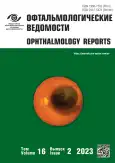Опыт применения средств для терапевтической гигиены век у пациентов с анофтальмом, перенёсших травму глазного яблока
- Авторы: Баранова Н.А.1, Сенина И.А.1, Фролов О.А.1
-
Учреждения:
- Диагностический центр № 7 (глазной) для взрослого и детского населения
- Выпуск: Том 16, № 2 (2023)
- Страницы: 73-82
- Раздел: В помощь практикующему врачу
- URL: https://journals.rcsi.science/ov/article/view/253838
- DOI: https://doi.org/10.17816/OV321442
- ID: 253838
Цитировать
Аннотация
Актуальность. Одной из задач глазного протезирования является предупреждение развития патологических процессов в веках и конъюнктиве анофтальмической полости.
Цель — оценка эффективности средств терапевтической гигиены век «Блефаросалфетка» и «Блефарогель очищение» (Гельтек-Медика, Россия), применяемых в послеоперационном позднем и отдалённом периодах реабилитации у пациентов, утративших глазное яблоко вследствие травмы.
Материалы и методы. Для исследования были сформированы 3 основные (50 пациентов) и 3 соответствующие им контрольные группы (50 пациентов). Обследование пациентов включало: сбор жалоб, анамнеза; биомикроскопию век, конъюнктивы анофтальмической полости и поверхности глазного протеза. В основных группах в течение 8 нед. применялись средства для терапевтической гигиены век в сочетании с регулярной обработкой глазного протеза. В контрольных группах упомянутые препараты не использовались. Оценка и анализ эффективности средств проводилась через 1, 2 и 4 нед. в I группе и через 4 и 8 нед. во II и III группах на основании динамики жалоб пациентов и показателей объективного осмотра.
Результаты. В I и II основных группах отмечалась положительная динамика: нормализация состояния век и конъюнктивы анофтальмической полости; повышение комфортности ношения глазного протеза. В III основной группе и во всех контрольных группах выраженной положительной динамики не отмечалось.
Выводы. Результаты применения средств «Блефаросалфетка», «Блефарогель очищение», входящих в курс терапевтической гигиены век, показали высокую эффективность, что даёт основание рекомендовать их в послеоперационном позднем и отдалённом периодах реабилитации у пациентов с анофтальмом.
Ключевые слова
Полный текст
Открыть статью на сайте журналаОб авторах
Надежда Александровна Баранова
Диагностический центр № 7 (глазной) для взрослого и детского населения
Автор, ответственный за переписку.
Email: baranova-n@bk.ru
врач-офтальмолог, заведующая лабораторией сложного глазного протезирования
Россия, Санкт-ПетербургИрина Анатольевна Сенина
Диагностический центр № 7 (глазной) для взрослого и детского населения
Email: i.senina@mail.ru
врач-офтальмолог
Россия, Санкт-ПетербургОлег Алексеевич Фролов
Диагностический центр № 7 (глазной) для взрослого и детского населения
Email: oleg524@mail.ru
ORCID iD: 0000-0002-0162-5454
врач-офтальмолог, главный врач
Россия, Санкт-ПетербургСписок литературы
- Шиф Л.В. Глазное протезирование. Москва: Медицина, 1981. 136 с.
- Садовская Е.П. Особенности глазного протезирования в зависимости от клинико-анатомических характеристик анофтальма: дис. … канд. мед. наук. Москва, 2005. 206 с.
- Шиф Л.В. Удаление глаза и вопросы косметики. Москва: Медицина, 1973. 120 с.
- BenEzra D. Blepharitis and conjunctivitis. Guidelines for diagnosis and treatment. Editorial Glosa, 2006. 248 p.
- Jang S.Y., Lee S.Y., Yoon J.S. Meibomian gland dysfunction in longstanding prosthetic eye wearers // Br J Ophthalmol. 2013. Vol. 97. P. 398–402. doi: 10.1136/bjophthalmol-2012-302404
- Atin E., Meryem K.U., Seyda K.H.G. Meibomian gland dysfunction and its association with ocular discomfort in patients with ocular prosthesis // Eye Contact Lens: Sci Clin Pract. 2020. Vol. 46, No. 5. P. 285–290. doi: 10.1097/ICL.0000000000000646
- Chiang C.-C., Lin C.-L., Tsai Y.-Y., et al. Patients with blepharitis are at elevated risk of anxiety and depression // PLoS ONE. 2013. Vol. 8, No. 12. ID e83335. doi: 10.1371/journal.pone.0083335
- Кинтюхина Н.П. Роль критериев морфофункционального состояния век в диагностике и оценке эффективности лечения хронических блефаритов: дис. … канд. мед. наук. Москва, 2019.
- Kim S.E., Yoon J.S., Lee S.Y. Tear measurement in prosthetic eye users with fourier-domain optical coherence tomography // Am J Ophtalmol. 2010. Vol. 149, No. 4. P. 602–607. doi: 10.1016/j.ajo.2009.10.023
- Трубилин В.Н., Полунина Е.Г., Маркова Е.Ю., и др. Терапевтическая гигиена век в алгоритмах профилактики и лечения заболеваний глазной поверхности. Ч. 1 // Офтальмология. 2016. Т. 13, № 2. С. 122–127. doi: 10.18008/1816-5095-2016-2-122-127
- Трубилин В.Н., Полунина Е.Г., Маркова Е.Ю., и др. Терапевтическая гигиена век в алгоритмах профилактики и лечения заболеваний глазной поверхности. Ч. 2 // Офтальмология. 2016. Т. 13, № 3. С. 205–212. doi: 10.18008/1816-5095-2016-3-205-212
- Друянова Ю.С. О применении пластмассовых глазных протезов отечественного производства // Офтальмологический журнал. 1984. № 5. С. 305–306.
- Баранова Н.А., Сенина И.А., Николаенко В.П. Влияние формы опорно-двигательной культи на результат глазного протезирования при разных методах удаления глаза // Офтальмологические ведомости. 2020. Т. 13, № 1. С. 77–85. doi: 10.17816/OV13531
- Давыдов Д.В. Медико-биологические аспекты комплексного использования биоматериалов у пациентов с анофтальмом: дис. … д-ра. мед. наук. Москва, 2000.
- Давыдов Д.В., Баранова Н.А. Результаты хирургического лечения и реабилитации пациентов с посттравматической субатрофией и анофтальмическим синдромом в сочетании с костными деформациями глазницы // Офтальмологические ведомости. 2022. Т. 15, № 4. С. 15–26. doi: 10.17816/OV115061
Дополнительные файлы











